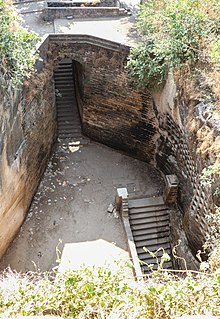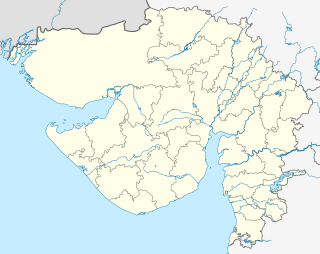Related Research Articles

Navaghana was an early Chudasama king known only from the ballads and folklore of Saurashtra region of Gujarat, India. His capital was at Vamanasthali which he later moved to Junagadh during his last years of reign.
Dyas, also spelled Diyas, was an 11th-century Chudasama king of Saurashtra region of western India mentioned in bardic literature and folklore. He is not known from historical sources. He was defeated and killed by Patan Raja. So Chudasama domain fell under Chaulukyas for some years.
The Chudasama dynasty ruled parts of the present-day Saurashtra region of Gujarat state in India between the 9th and 15th centuries. Their capital was based in Junagadh and Vamanasthali, and they were later classified among the Rajput clans.Who claim to be of Lunar race which lord Krishna sprung.
Paramardi was a king of the Chandela dynasty of central India. He was the last powerful Chandela king, and ruled the Jejakabhukti region. Around 1182-1183 CE, he was defeated by Prithviraj Chauhan, who raided the Chandela capital Mahoba. Paramardi managed to recover the Chandela power over the next few years, but was defeated by the Ghurid general Qutb al-Din Aibak around 1202-1203 CE.
Mandalika III, called by epithet Ra Gangajalio, was a Chudasama king of Saurashtra region of western India who reigned from 1451 CE to 1472 CE. His capital was at Junagadh.
Ra Mahipala III was a Chudasama king of Saurashtra region of western India who reigned from 1430 CE to 1451 CE. His capital was at Junagadh.
Ra Jayasimha II was a Chudasama king of Saurashtra region of western India who reigned from 1416 CE to 1430 CE. His capital was at Junagadh.
Ra Meliga, also known as Melaga or Maleka, was a Chudasama king of Saurashtra region of western India who reigned from 1400 CE to 1416 CE. He remove his capital from Vanthali back to Junagadh, from which place he expelled the thanadar appointed by Gujarat Sultan. Thus Gujarat Sultan Ahmad Shah I sent an army against Junagadh. He captured Vanthali and later Junagadh was besieged. Meliga left to a fort on Girnar hill which was inaccessible to the forces. So the forces left and placed two officers in Junagadh to collect tribute. Meliga died and was succeeded by his son Jayasimha II in 1416 CE.
Ra Mokalasimha, also known as Muktasimha, was a Chudasama king of Saurashtra region of western India who reigned from 1384 CE to 1396 CE. He ruled from Junagadh and later moved his capital to Vanthali when Saurashtra came under influence of the Delhi Sultanate.
Raul Mahipala II was a Chudasama king of Saurashtra region of western India who reigned from 1378 CE to 1384 CE.
Jayasimha I was a Chudasama king of Saurashtra region of western India who reigned from 1351 CE to 1378 CE. His capital was at Junagadh.
Khengara was a Chudasama king of Saurashtra region of western India who reigned from 1331 CE to 1351 CE. His capital was at Junagadh.
Mahipala I was a Chudasama king of Saurashtra region of western India who reigned from 1308 CE to 1331 CE. His capital was at Junagadh.
Mandalika I was a Chudasama king of Saurashtra region of western India who reigned from 1294 CE to 1306 CE. His capital was at Junagadh.
Khengara was a Chudasama king of Saurashtra region of western India who reigned in the 12th century. His capital was at Junagadh. He was a contemporary of Jayasimha Siddharaja, the Chaulukya ruler of Anahilapataka. According to bardic tales, he was a son of Navaghana and had succeeded him.
Ranakadevi was a legendary 12th century queen of Khengara, the Chudasama ruler of Saurashtra region of western India. She is mentioned in the bardic tragic romance representing the battle between Chudasama king Khengara and Chaulukya king Jayasimha Siddharaja. However, this legend is not credible.
Navaghana was a Chudasama king of Saurashtra region of western India who reigned in the late 11th century. His capital was at Junagadh. He was a contemporary of Jayasimha Siddharaja, the Chaulukya ruler of Anahilapataka. According to bardic legends, Jayasimha attacked during his reign and he was defeated and became is vassal. He moved capital to Junagadh. He was succeeded by Khengara who had vowed to take revenge.
Jayasimha was an early Chudasama king known only from the ballads and folklore of Saurashtra region of Gujarat, India.
The early history of Chudasama dynasty of Saurashtra region is almost lost. The bardic legends differs very much in names, order and numbers so they are not considered reliable. Mandalika Kavya, a Sanskrit poem by Gangadhara, gives some information on dynasty but it has little historical value. Some of their inscriptions gives their genealogy but they too differ in order of succession. Ranchhodji Diwan, A. K. Forbes, James Burgess and Gaurishankar Oza had tried to fix genealogy and chronology. They ruled about from Vikram Samvat (VS) 900 to VS 1527.

Ra Khengar Vav or Ra Khengar stepwell is a 13th-century stepwell located near Koyliphatak village between Vanthali and Junagadh in Gujarat, India.
References
- 1 2 Harold Wilberforce-Bell (1916). The History of Kathiawad from the Earliest Times. London: William Heinemann. pp. 54–83.

- 1 2 3 Watson, James W., ed. (1884). Gazetteer of the Bombay Presidency : Kathiawar. VIII. Bombay: Government Central Press. p. 495.
